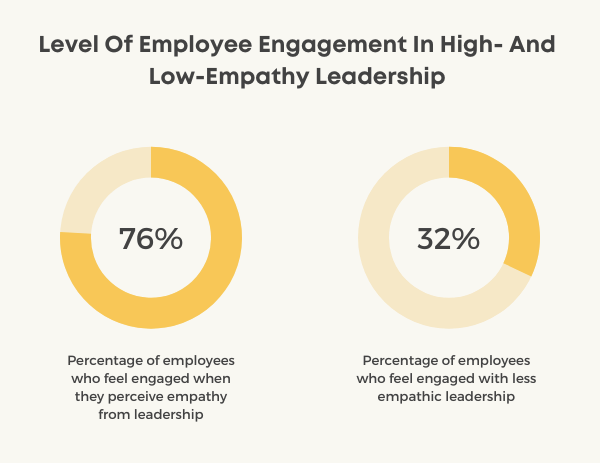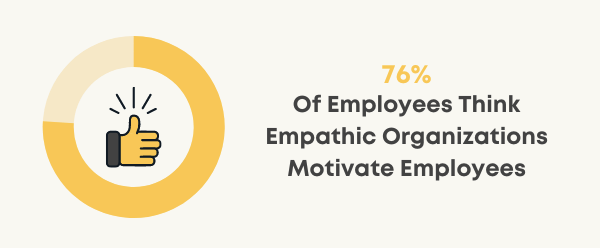What is the role of empathy in leadership?
What is empathy’s influence on business? Why is leading with empathy good?
We will know once we take a look at the empathy leadership statistics. In this article, you can find out why leading with empathy is good for the business, employees, how it helps motivation, productivity, mental health, and more. Let’s get started then!
Empathy Leadership Statistics
(Editor’s Pick)
- Only 40% of leaders have the needed empathy skills.
- 61% of employees under empathic leadership report feeling innovative.
- Out of all employees, only 63% believe their CEOs are empathic.
- 54% of employees with high empathy leadership report burnout.
- CEOs (97%) believe they are empathic of employees’ mental health.
18 Empathy Leadership Statistics
1. The lack of empathy in business costs an average brand up to $300 million of lost revenue annually.
According to a 2018 study by M&C Saatchi, 18% of consumers stopped using a brand in the previous year because of the difference between marketing and experience. The study included 34,000 consumers in China, the UK, the US, and France across 225 major brands. Furthermore, it turns out the lack of empathy costs brands up to $300 million in lost revenue every year.
Source: M&C Saatchi
2. Only 40% of leaders have professional empathy skills.
According to DDI, empathy levels are low in business leaders, as only 40% of them have proficient empathy skills. The study included 15,000 business leaders in high-performing leadership settings.
Source: DDI
3. Empathy is the ultimate competence for good leadership and one of the three strongest indicators of senior executive efficacy.
According to research from Management Research Group, empathic leaders are also very effective at senior executive levels. Similarly, a study by CCL showed that leaders are more productive when they have enhanced empathy. The 2016 CCL study concluded that from 6,731 leaders across 38 countries.
Source: Management Research Group
4. Employees (61%) under empathic leaders report they are more able to be innovative.
According to a study of 889 employees, 61% of employees who have empathic leaders said they are more able to be innovative under such leadership. On the other hand, only 13% of those who have less emphatic leaders reported the same.
Source: Catalyst
5. Almost eight in 10 employees who encountered empathy from their leaders reported feeling engaged.
When employees experience empathy from their leadership, 76% of them reported they were engaged. In comparison, 32% of employees who have less empathic leadership said they were engaged, too.
Source: Catalyst


6. Out of those with empathic leaders, 50% of employees reported their workplace was inclusive.
According to empathy leadership statistics, one in two employees under empathy leadership reported their workplace was inclusive. On the other hand, only 17% of those who had less empathic leadership said their workplace was inclusive.
Source: Catalyst
7. Around 86% of employees under empathy leadership reported a positive work-life balance.
Almost nine in 10 employees (86%) report they can juggle work-life obligations under empathic leaders. In comparison, only 60% of employees who felt less empathy from their leaders reported the same.
Source: Catalyst
8. Only 48% of employees think companies are empathic, compared to 68% of CEOs.
Interesting findings from the 2020 State of Workplace Empathy by Businessolver show us that CEOs (68%) are more likely to think companies are empathetic than employees do (48%). Moreover, to show the importance of empathy in leadership, over 90% of HR professionals, employees, and CEOs have said empathy is important, every year since 2017.
Source: Businessolver
9. Only 63% of employees think their CEO is empathetic, while 80% believe their colleagues are empathetic.
Compared to 2019, employees experience less empathy in their CEOs in 2020 (63%). On the other hand, employees feel the most empathy from their colleagues, as 80% of employees said their coworkers are empathetic.
Source: Businessolver
10. Over 70% of employees and 80% of CEOs think empathy can be learned.
Both employees and CEOs believe empathy can be learned. According to research data, 73% of employees think so. In comparison, only 54% of them thought the same in 2016. Furthermore, 80% of CEOs think empathy can be learned, while 57% of them thought the same in 2016.
Source: Businessolver
11. 76% of employees believe empathic organization motivates employees.
In 2020, 76% of employees reported that empathetic organizations help to motivate employees. However, in 2019, only 65% believed the same to be true. On the other hand, only 50% of CEOs believe empathy is a driver of motivation and productivity.
Source: Businessolver


12. 84% of Gen Zers would consider leaving their company for a similar job under more empathic leadership.
Gen Z values empathy so much that 84% of Gen Z employees would leave their company if they had a similar offer from another company under more empathic leadership. Moreover, 83% of them would choose an employer with more empathy over an employer offering a higher salary.
Source: Businessolver
13. Nine in 10 employees believe organizations are more empathic if they recognize employees’ professional and personal accomplishments.
While 90% of employees believe organizations are more empathic if they recognize employees’ accomplishments, 41% report employers do not give employees enough recognition. Moreover, they view recognition as both monetary rewards and feedback-based rewards.
Source: Businessolver
14. 93% of employees say it boosts their productivity when employers recognize their professional accomplishments.
When it comes to empathy, employees value recognition for their accomplishments from their leaders. More than nine in 10 say it boosts their productivity (93%), while 92% also say it increases the likelihood of employee retention.
Source: Businessolver
15. Employees with high manager empathy report feeling less burnout (54%) than employees with low empathy from managers (64%).
It turns out empathy from leaders and managers positively affects burnout. For instance, only 54% of women said they feel burnout under high empathy managers, compared to 54% of those whose managers have less empathy.
Source: Catalyst
16. More than 8 in 10 CEOs believe empathy has a positive effect on business outcomes.
Around 84% of CEOs believe that empathy influences business outcomes positively. Moreover, 72% of CEOs also believe that empathy positively influences the motivation of employees. So, empathy leadership helps to motivate employees and also results in better business outcomes.
Source: Businessolver


17. Staggering 90% of workers believe that empathy helps make a healthy workplace culture.
According to SHRM, 90% of workers believe that empathy helps create a healthy workplace culture. This is according to a study that surveyed 2.500 US workers. It helps to drive toxicity out of the organization and more, resulting in healthy workplace culture.
Source: SHRM
18. 97% of CEOs say all levels of their companies are empathic of employees’ mental health, 69% of employees agree.
Mental health is an important part of the work and life of every employee, according to the State of the Workplace Empathy Report for 2020. Almost all CEOs (97%) agree their organizations show empathy for employees’ mental health. On the other hand, only 68% of employees agree with it.
Source: Businessolver
Final Verdict
In conclusion, empathy in leadership influences employees and business outcomes in a positive manner. While there is a lot of evidence to show that, many studies will definitely come out in the future to show us the progress of empathy leadership statistics. Moreover, leadership statistics, as well as transformational leadership statistics, and servant leadership statistics can show us the state of other leadership styles and how they can affect business outcomes and employees.


































Find Us on Socials